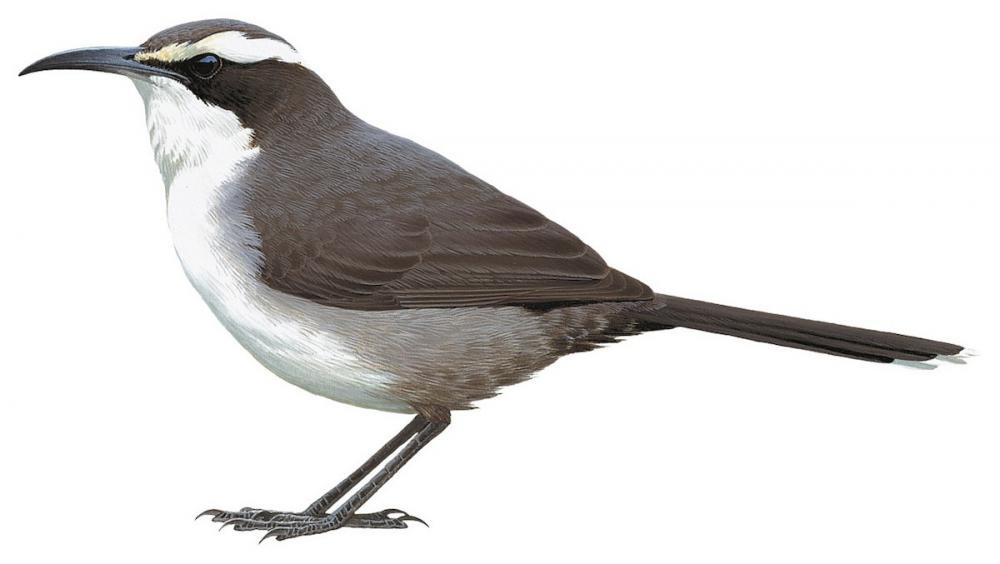White-browed Babbler / Pomatostomus superciliosus

White-browed Babbler
SCI Name:
Protonym: [Pomatorhinus] Superciliosus Trans.Linn.Soc.London(1), 15(1826) p.330
Taxonomy: Passeriformes / Pomatostomidae / Pomatostomus
Taxonomy Code: whbbab3
Type Locality: south coast of Australia; here further restricted to Yorke Peninsula, South Australia.
Author: Vigors & Horsfield
Publish Year: 1827
IUCN Status: Least Concern
DEFINITIONS
POMATOSTOMUS
(Pomatostomidae; Ϯ Grey-crowned Babbler P. temporalis) Gr. πωμα pōma, πωματος pōmatos lid, cover; στομα stoma, στοματος stomatos mouth; "Gen. POMATOSTOMUS **) nov. gen. Deckelschnabel. 467. 1. P. temporalis Nob. — Pomatorhinus temporalis Vig. Horsf. Trans. Lin. Soc. XV. p. 330. Turdus frivolus Lath? — Pomatorhinus trivirgatus Temm. Pl. col. 443. — Pomatorhinus temporalis Gould. B. Austr. IV. tab. 20. Pomatorhinus frivolus Gray Gen. Birds No. 8 et P. temporalis No. 9 et P. trivirgatus. No. 10. ... 468. 2. P. superciliosus Nob. — Pomatorhinus superciliosus Vig. Horsf. Trans. Lin. Soc. XV. p. 330. — id. Gould Birds Aust. IV. tab. 21. ... **) Unter diesem Namen lassen sich die Neuholländischen, bisher zu Pomatorhinus gestellten Formen absondern. Die Flügel sind anders geformt, die 3te und 4te Schwinge verhältnissmässig länger; Schwanz ahgerundet [sic], weniger stufig mit breiteren Federn und weisser Spitzenfärbung. — Nahe verwandt mit P. temporalis ist: P. rubeculus. — Pomatorhinus rubeculus Gould." (Cabanis 1853); "Pomatostomus Cabanis, 1851 [= 1853], in Cabanis and Heine, Mus. Hein., 1 (1850), p. 83. Type, by subsequent designation (G. R. Gray, 1855, Cat. Gen. Subgen. Birds., p. 45), Pomatorhinus temporalis Vigors and Horsfield." (Deignan in Peters 1964, X, 279).
Synon. Morganornis.
superciliosa / superciliosum / superciliosus
L. superciliosus supercilious, haughty, eye-browed < supercilium eyebrow.
● ex “Supercilious Duck” of Latham 1785 (Anas).
● ex “Little Green and Orange-coloured Kingfisher” of Edwards 1758 (syn. Chloroceryle aenea).
● ex “Gorge-jaune de Saint-Domingue” of d’Aubenton 1765-1781, pl. 686, fig. 1 (syn. Dendroica dominica).
● ex “Rousseau” of Levaillant 1800, pl. 66 (Lanius).
● ex “Apiaster madagascariensis” or “Guespier de Madagascar” of Brisson 1760 (Merops).
● ex “Yellow-browed Warbler” of Latham 1783 (syn. Phylloscopus humei).
● ex “Supercilious Fly-catcher” of Latham 1783 (unident.).
SUBSPECIES
White-browed Babbler (gilgandra)
SCI Name: Pomatostomus superciliosus gilgandra
gilgandra
Gilgandra, northern New South Wales, Australia.
White-browed Babbler (superciliosus)
SCI Name: Pomatostomus superciliosus superciliosus
superciliosa / superciliosum / superciliosus
L. superciliosus supercilious, haughty, eye-browed < supercilium eyebrow.
● ex “Supercilious Duck” of Latham 1785 (Anas).
● ex “Little Green and Orange-coloured Kingfisher” of Edwards 1758 (syn. Chloroceryle aenea).
● ex “Gorge-jaune de Saint-Domingue” of d’Aubenton 1765-1781, pl. 686, fig. 1 (syn. Dendroica dominica).
● ex “Rousseau” of Levaillant 1800, pl. 66 (Lanius).
● ex “Apiaster madagascariensis” or “Guespier de Madagascar” of Brisson 1760 (Merops).
● ex “Yellow-browed Warbler” of Latham 1783 (syn. Phylloscopus humei).
● ex “Supercilious Fly-catcher” of Latham 1783 (unident.).
White-browed Babbler (ashbyi)
SCI Name: Pomatostomus superciliosus ashbyi
ashbyi
Edwin Ashby (1861-1941) English conchologist, ornithologist, settled in Australia, founder member of RAOU (syn. Aegintha temporalis, syn. Cacatua sanguinea gymnopis, syn. Calamanthus montanellus, syn. Epthianura aurifrons, syn. Falco hypoleucos, syn. Glossoptila pusilla, subsp. Malurus cyaneus, syn. Pachycephala pectoralis, subsp. Pomatostomus superciliosus, subsp. Sericornis frontalis, subsp. Sphecotheres vieilloti, subsp. Strepera graculina, syn. Sugomel niger).
White-browed Babbler (centralis)
SCI Name: Pomatostomus superciliosus centralis
centralis
L. centralis, centrale central, in the middle < centrum middle point, centre < Gr. κεντρον kentron sharp point, stationary point of a pair of compasses. A good proportion of the names here refer to forms collected in "Central Africa," i.e. the eastern Congo and the Rift Valley lakes (e.g. subsp. Bradypterus baboecala, subsp. Chlorocichla flaviventris, subsp. Malimbus rubricollis, subsp. Sarothrura pulchra, subsp. Turdus pelios). Some further examples follow.
• "Dieselbe steht in Bezug auf Grösse zwischen cardinalis und massaicus in der Mitte." (Neumann 1900) (subsp. Dendropicos fuscescens).
• "Distribution. Endemic to Peru on east Andean slope from Río Huallaga through Pasco to Junín west of the Río Ene and north of the Río Mantaro ... The scientific name reflects the range of this species near the geographic center of Peru." (Hosner et al. in M. Isler et al. 2020) (Grallaria).
• "Intermediate in size between N. f. flavicollis (Vieill.) and N. f. melanoxantha (Lcht.)" (Hellmayr 1907) (subsp. Hemithraupis flavicollis).
• "These birds are intermediate between N. famosa and N. cupreonitens, and resemble birds labelled by Neumann in the Tring Museum with the MS. name Nectarinia famosa centralis" (van Someren 1916) (subsp. Nectarinia famosa).
• "RANGE. —Eastern part of the central Solomon Islands (Kulambangra, New Georgia, Vangunu, and Gatukai)." (Mayr 1932) (subsp. Pachycephala pectoralis).
• "zentralbrasilianischen Hochlandes (Matto-grosso. S. Goyaz. N.-São Paulo. W.-Minas Geraës)" (Hellmayr 1920) (subsp. Ramphocelus carbo).
• "the Central American form is named CICCABA VIRGATA CENTRALIS, subsp. nov. ... Chivela, Oaxaca, Mexico." (Griscom 1929) (subsp. Strix virgata).
• "Tang- (Dang-) la Range, Central Tibet, Tang-la Pass" (Sushkin 1926) (subsp. Tetraogallus tibetanus).
UPPERCASE: current genus
Uppercase first letter: generic synonym
● and ● See: generic homonyms
lowercase: species and subspecies
●: early names, variants, mispellings
‡: extinct
†: type species
Gr.: ancient Greek
L.: Latin
<: derived from
syn: synonym of
/: separates historical and modern geographic names
ex: based on
TL: type locality
OD: original diagnosis (genus) or original description (species)












